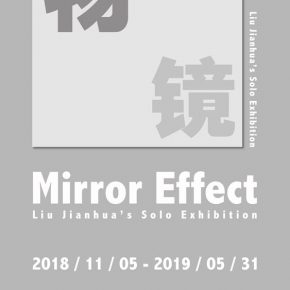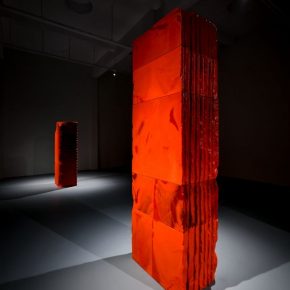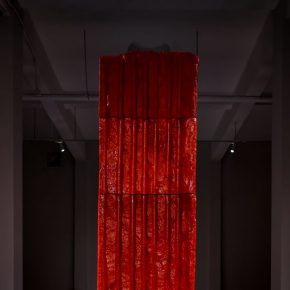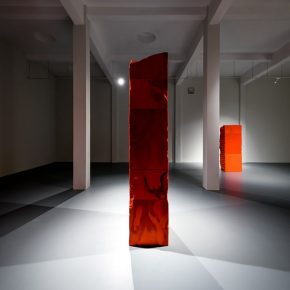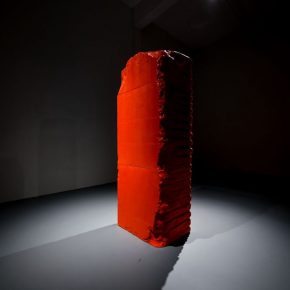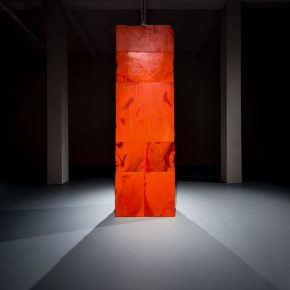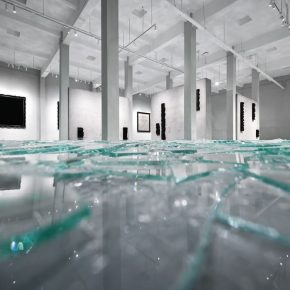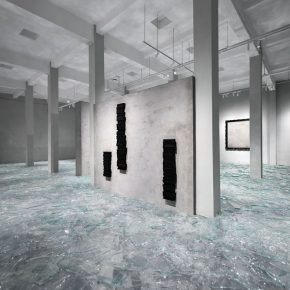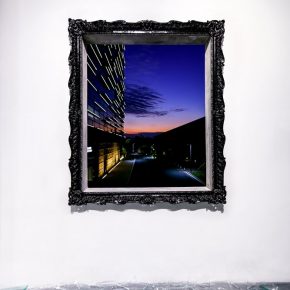
As the invited artist for the annual “Annealing” project of Shanghai Museum of Glass, Liu Jianhua’s latest solo exhibition “Mirror Effect” has been open to the public since November 2018 in the newly reconstructed contemporary art space of the Museum. The exhibition presents his new creations which consist of three pieces/sets of newly completed glass installations, with an organic spatial logic, his work penetrates the second floor space. With a semi-open state, the exhibition introduces the natural flow outside the window. The sense of depression in his installation and the effects on his skin alter with the changes of the four seasons have become part of the exhibition field, encouraging the visitors to share and think from the visual, auditory, tactile and psychological aspects, they might then further question their connection with daily life while resetting and breaking the established concepts they are accustomed to.
Three of his creations are displayed in two separate but connected exhibition halls. The link with the space has become an important dimension of the exhibition. Since the beginning of preparations for the exhibition, the artist has consciously established and maintained a close relationship with the exhibition space by various means, so that the preparation and installation process of the exhibition have become an integral part of the exhibition. Liu Jianhua combines the characteristics of the exhibition space with the features of glass to extend the sensory experience of the audience from visual to auditory and tactile ones.
His work Stele has created a solemn and oppressive impression for the audience with its huge volume and alert bloody appearance. In sharp contrast, embarrassment, depression and uneasiness exist in another exhibition hall connected to it. In the second exhibition hall, the irregular “cracking, creaking” sound forms a clear contrast with the quiet exhibition hall; the sound reminds the audience that they are in a strange location. Black Body placed in the center of the exhibition hall is composed of a book-shaped wall made of glass and cement. Each book wall is 2.5 meters high and nearly half a meter thick. The behemoth composed of three book-shaped walls stands in front of audiences, hindering their advancement and adding a layer of psychological pressure to an audience in the atmosphere of crisis. Respiratory Landscape, based on the exterior wall of the exhibition hall, further promotes the sense of oppression and uncertainty of an audience and pushes the complicated emotions scattered in this field to a peak.
In Stele, Black Body and Respiratory Landscape, the artist makes full use of glass as a raw material for creation. As an important contemporary Chinese artist, Liu Jianhua has long been known for his use of ceramics for his creations. He often uses daily necessities or abstract forms as his prototype to reflect the current social and life issues under a seemingly ordinary surface. Liu Jianhua’s works seem to be light in visual effect but actually they are hard and fragile. Although glass and ceramics have seemingly different forms and properties, in Liu Jianhua’s view, they are closely related to the materials of Nature. For the first time, Liu has dramatically used glass for creation which continues with Liu Jianhua’s sensitivity to materials, while the clues and context of his long-term creative career are also revealed.
“Breaking” is the method applied by Liu Jianhua in the early stage of his ceramic creation. In this exhibition, he tried to create ceramics on broken glass and experimented with the interoperability of artistic languages in an unknown field. Meanwhile, Liu Jianhua intends to break the established comprehension of glass as an everyday object that can be seen everywhere, “attaching” enamel and dark colors onto glass and “breaking” the transparency of glass. Although glass is used, the artist hopes that the audience “cannot see” glass in the work. He specially chooses to use the blood red and black to create the works Stele and Black Body and Respiratory Landscape. When the original crystal clear glass is worn away, the artist realizes his desire to present a different property of glass. In this way, Liu Jianhua has constantly challenged the viewer’s visual experience and established cognition in this practice, trying to open up a new sensory experience and thought process for visitors.
Actually, as early as 2000, Liu Jianhua began a dialogue with “glass”. At that time, he considered using glass as a sculpture medium and conducted a series of experiments. In 2006, he embarked on a small-scale creation based on glass. When the “Annealing” project started in 2015, Zhang Lin, Director of the Shanghai Museum of Glass and Li Li, the Artistic Director of the project, had a discussion on this project with Liu Jianhua. Under the influence of various factors, Liu Jianhua officially accepted the invitation this year and started his “annealing” creation. When he began to prepare for the exhibition at the beginning of 2018, he first conducted a comprehensive research and analysis on glass. For Liu Jianhua, glass is a mature material and its complexity does not lie in the technique level, but in the relationship between the material and the work, the balance between creative concepts and the possibilities of implementation is therefore particularly important.
Glass as a media, for Liu Jianhua, it is an important experience in his creative career. It does not just proceed the long-term creative clues he persists in, but he also tries to find new perspectives and breakthroughs in his personal artistic language system. As the artist said, “People are working hard to see the other side, while tenacity is the key driving force that supports them.” The biggest challenge for an artist is himself, his curiosity and persistence responding to the unknown have become the foundation for an artist who dares to break through and experiment.
The exhibition will remain on view until May 31, 2019.
Text edited CAFA ART INFO, translated and edited by Sue/CAFA ART INFO.
Photo Courtesy of Shanghai Museum of Glass


